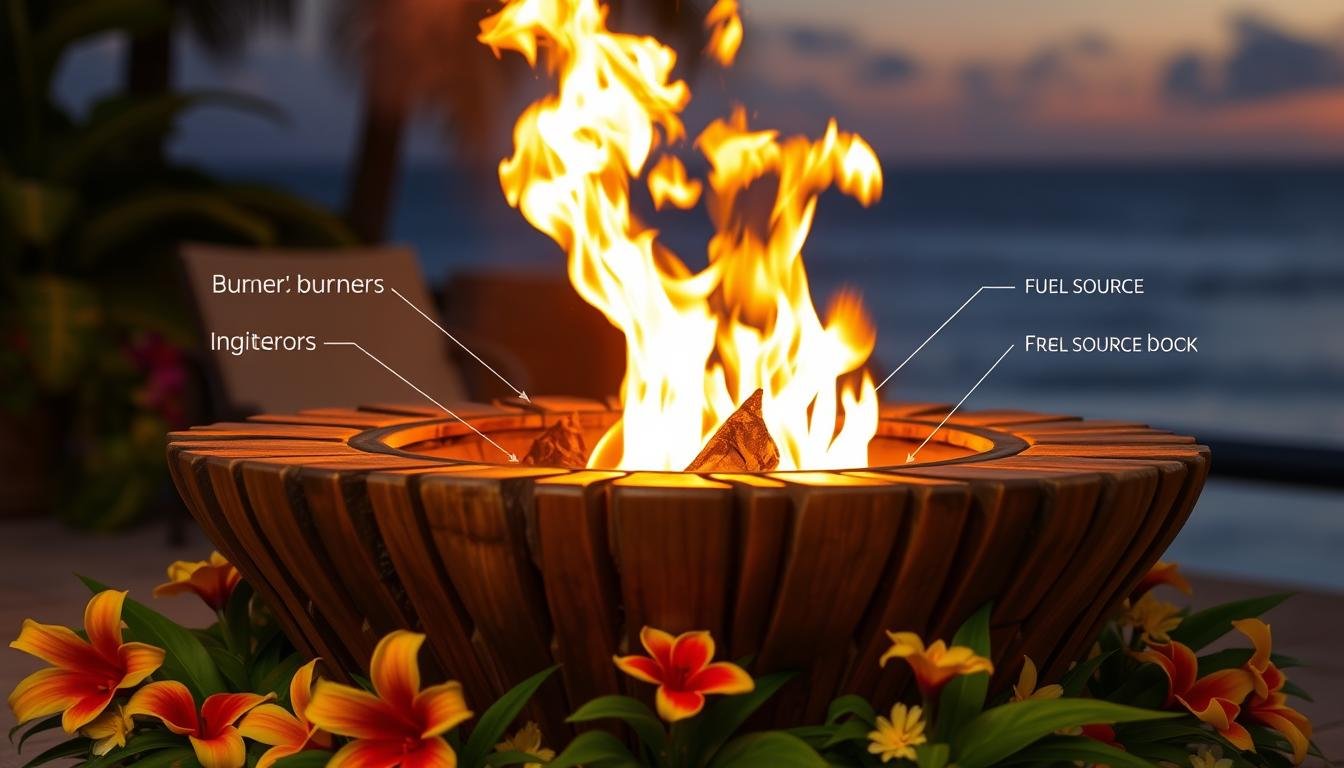A cozy fire pit on a chilly evening can be a wonderful way to spend time with family and friends. However, to keep your fire pit in good condition, regular maintenance is crucial.
Depending on usage and whether it’s kept covered, a deep cleaning is recommended every six months. The method of cleaning varies based on the material and fuel type – wood or gas.

Proper care extends the lifespan of your fire pit and maintains its appearance. This guide will walk you through comprehensive tips for different types of fire pits, ensuring you can enjoy your fire safely and efficiently.
Why Regular Fire Pit Cleaning Matters
The importance of regular fire pit cleaning cannot be overstated, as it directly impacts both performance and safety. A clean fire pit is not just aesthetically pleasing; it’s also crucial for ensuring that your outdoor gatherings remain safe and enjoyable.
Benefits of a Well-Maintained Fire Pit
A well-maintained fire pit offers several benefits. It enhances the overall appearance of your outdoor space, ensures efficient burning, and reduces the risk of accidents. Regular cleaning also helps in identifying any potential issues early on, such as damage or wear, allowing for timely repairs.
How Often You Should Clean Your Fire Pit
The frequency of cleaning your fire pit depends on its usage. For frequently used fire pits, a quick cleanup after each use is recommended, followed by a deeper clean every few weeks. For less frequently used fire pits, a thorough cleaning before and after the usage season is advisable. It’s also important to consider weather conditions and storage methods when determining your cleaning schedule.
| Usage Frequency | Recommended Cleaning Schedule |
|---|---|
| Daily/Weekly | Quick cleanup after each use, deep clean every 2 weeks |
| Monthly | Quick cleanup after each use, deep clean every 1-2 months |
| Seasonal | Deep clean before and after usage season |
tag.
6. To validate keyword distribution, I will ensure that the density of words is up to 2%, meaning no more than two repetitions of one keyword per 100 words.
7. I will create short paragraphs for readability and ensure that the Flesch Reading Ease and the Flesch Kincaid Grade are within the specified range (8th & 9th grade school grade) and verify the Flesch score between 60-70.
8. I will keep in mind the recommended text size (175 words) for Section 3 and take into account all H2, H3 headings.
Here’s the content for Section 3:
Preparing for Fire Pit Cleaning
To ensure a safe and efficient cleaning process, preparation is essential. Before you start cleaning your fire pit, it’s crucial to take necessary precautions and gather the required cleaning supplies.
Essential Cleaning Supplies You’ll Need
Having the right cleaning supplies is vital for effectively cleaning your fire pit. You’ll need protective gloves, safety goggles, a long-sleeved shirt, and long pants to prevent skin exposure. For tougher stains, muriatic acid may be required, but handle it with caution as it can cause burns and blindness. Ensure you have a bucket of water nearby to rinse any affected areas.
- Protective gloves
- Safety goggles
- Long-sleeved shirt and long pants
- Muriatic acid (for tough stains)
- Water
Safety Precautions Before Cleaning
Before starting the cleaning process, make sure the fire pit is completely cool. Wear protective gear, including gloves and safety goggles, when handling cleaning chemicals like muriatic acid. Work in a well-ventilated area to avoid inhaling harmful fumes. Never mix different cleaning chemicals, as this can create harmful reactions. Additionally, keep a fire extinguisher nearby as a precautionary measure.

Fire Pit Cleaning Tips for Different Materials
Fire pits come in various materials, each with its own cleaning requirements to ensure longevity and performance. The material of your fire pit plays a significant role in determining the appropriate cleaning method. Understanding these differences is crucial for maintaining your fire pit’s condition and ensuring it remains a safe and enjoyable outdoor feature.
How to Clean Stone and Brick Fire Pits
Stone and brick fire pits require gentle cleaning to preserve their integrity. Start by removing any debris or ash from the pit. Use a soft-bristled brush to sweep away loose particles. For more thorough cleaning, mix a solution of mild soap and water, and use a soft cloth to wipe down the stone or brick surfaces. Avoid using harsh chemicals or abrasive cleaners that could damage the material. Regular cleaning will help maintain the appearance and durability of your stone or brick fire pit.
Cleaning Metal and Steel Fire Pits
Metal and steel fire pits are prone to rust if not properly maintained. Begin by removing any ash or debris. Use a wire brush to scrub away any rust spots, and then wipe the metal surfaces with a cloth dampened with soapy water. For tougher grime, a mixture of baking soda and water can be used as a gentle scrub. Dry the metal thoroughly after cleaning to prevent rust. Applying a rust-inhibiting coating can also help protect the metal.

Cast Iron Fire Pit Cleaning Methods
Cast iron fire pits require careful cleaning to maintain their seasoning. Avoid using soap or harsh chemicals, as these can strip away the seasoning. Instead, use a stiff brush to remove any food debris or ash. For tougher grime, mix equal parts water and white vinegar in the pit, and let it sit before scrubbing with a brush. Reseason the cast iron after cleaning to protect it from rust.
Gas Fire Pit Cleaning Techniques
Gas fire pits have integrated components that require special care when cleaning. Before cleaning, disconnect the gas supply to ensure safety. Use a cloth and a little soapy water to wipe down the interior, being cautious not to loosen any gas lines. Next, wipe down the exterior. For decorative elements like fire glass or lava rocks, use a soft-bristled brush to remove debris. Check the gas ports and burners for obstructions and clean them as needed. Regularly inspecting the gas connections and hoses during cleaning can help prevent issues.
Dealing with Common Fire Pit Problems
Common fire pit problems can detract from the overall outdoor experience, making it essential to tackle them head-on. Regular maintenance is key to preventing issues, but when problems arise, knowing how to address them is crucial.
Removing Stubborn Rust from Metal Fire Pits
For metal fire pits, rust can be a significant issue. To remove stubborn rust, start by clearing out the inside of the pit using a shovel or trowel. Then, use a durable brush to scrub the interior and exterior with a muriatic solution. This process helps restore the metal surface.
Effective Rust Removal Techniques:
| Method | Description | Effectiveness |
|---|---|---|
| Muriatic Solution | Scrubbing with a durable brush | High |
| Wire Brush | Manual scrubbing | Medium |
| Rust Converter | Chemical treatment | High |
Handling Soot and Smoke Stains
Soot and smoke stains can be challenging to remove, especially from different materials. To handle these stains, identify the material first. For most fire pits, a mixture of soapy water and a soft cloth can be effective. Scrub the interior and exterior gently to remove soot and smoke residue.
Different burning materials can affect the type and intensity of staining. Regular maintenance practices, such as cleaning after each use and using the right burning materials, can prevent deep-set stains from forming.
Proper Ash Disposal and Maintenance
To keep your fire pit in good condition, it’s crucial to understand the importance of ash disposal and maintenance. Proper ash disposal is not just about getting rid of waste; it’s also about safety and maintaining the longevity of your fire pit.
Safe Ways to Remove and Dispose of Ash
When removing ash from your fire pit, ensure that the ashes are completely cool. Use a metal scoop or shovel to transfer the ashes into a metal container. Store the container away from flammable materials until the ashes are disposed of properly. It’s recommended to mix the ashes with water before disposal to prevent any potential fires.
What Not to Burn in Your Fire Pit
Knowing what not to burn in your fire pit is crucial for its maintenance. Avoid burning accelerants like lighter fluid, as they can cause more harm than good. Household trash should also not be burned, as it can release harmful toxins into the air. Burning dry, split wood and small sticks is recommended, as they provide a clean and efficient burn.
| Materials to Burn | Materials Not to Burn |
|---|---|
| Dry, split wood | Accelerants (e.g., lighter fluid) |
| Small sticks | Household trash |
| Dead leaves | Treated wood |
Conclusion: Extending Your Fire Pit’s Lifespan
By following the cleaning and maintenance tips outlined in this article, you can significantly extend the lifespan of your fire pit. Regular cleaning schedules based on usage frequency are crucial for maintaining your fire pit’s condition. Investing in a quality fire pit cover will protect it from the elements, reducing debris accumulation. Proper fire management practices, such as using seasoned wood and avoiding water to extinguish flames, also contribute to a longer lifespan. By adopting these practices, you’ll ensure both safety and enjoyment for years to come.

John Carter is a firepit expert with 10+ years of experience in outdoor heating solutions. He specializes in firepit selection, installation, and maintenance, sharing tips on DIY projects, product reviews, and backyard entertainment. Passionate about creating cozy outdoor spaces, he helps homeowners choose the perfect firepit for their needs


